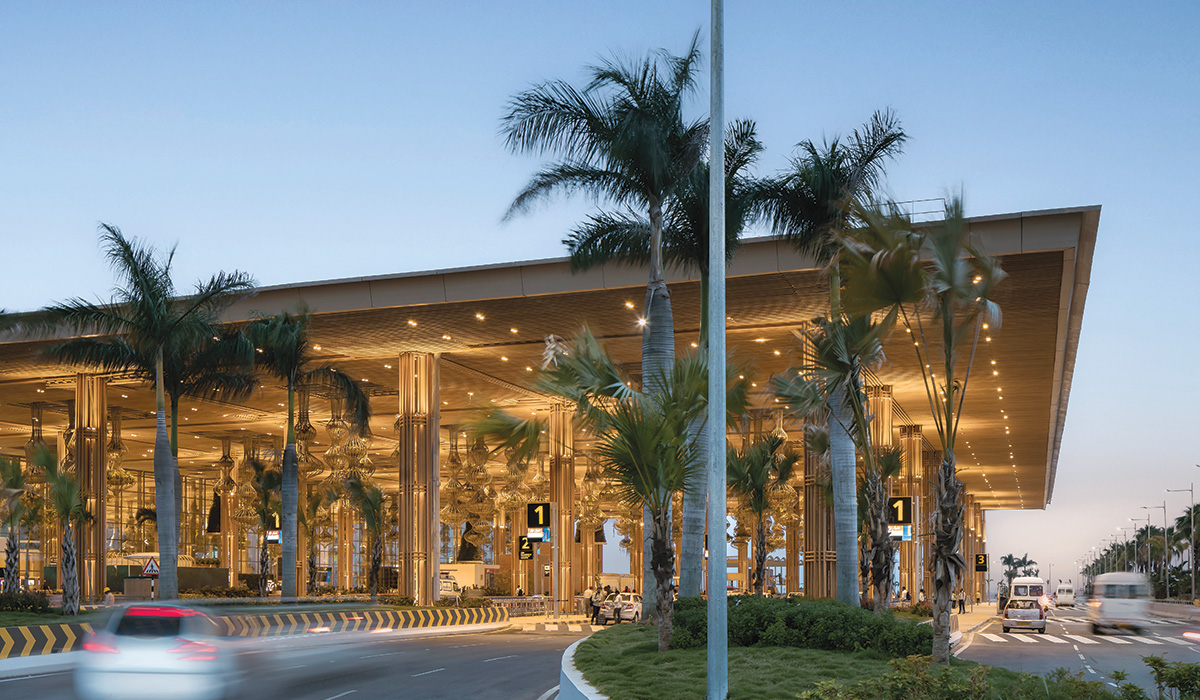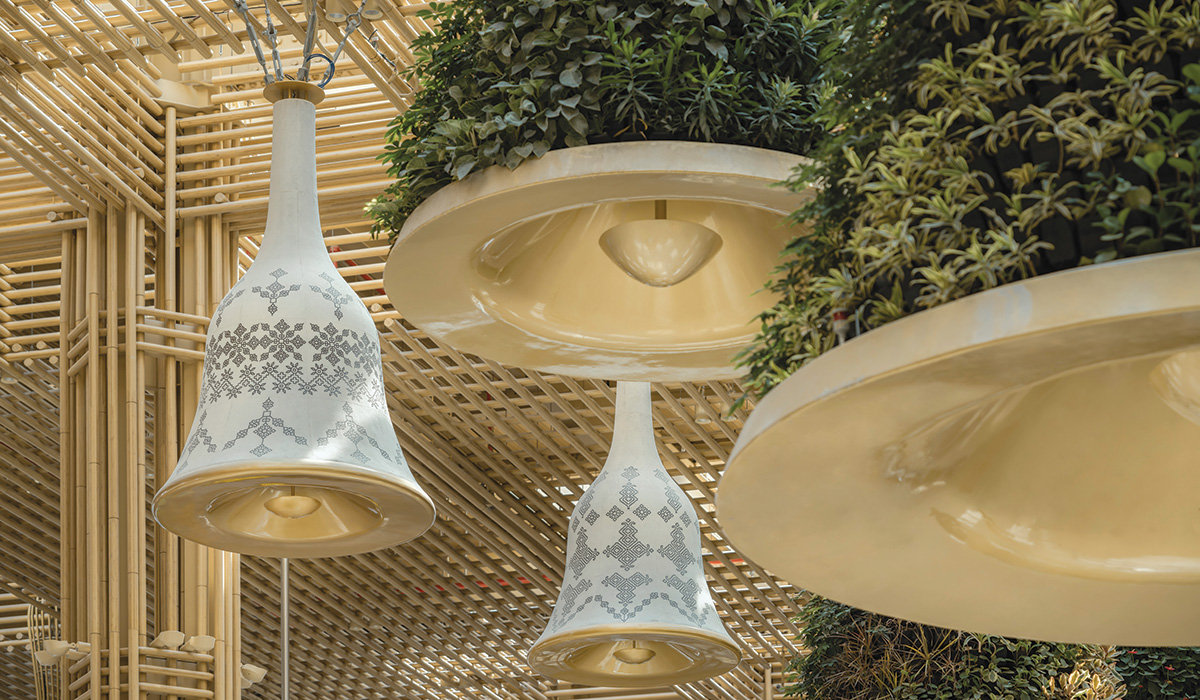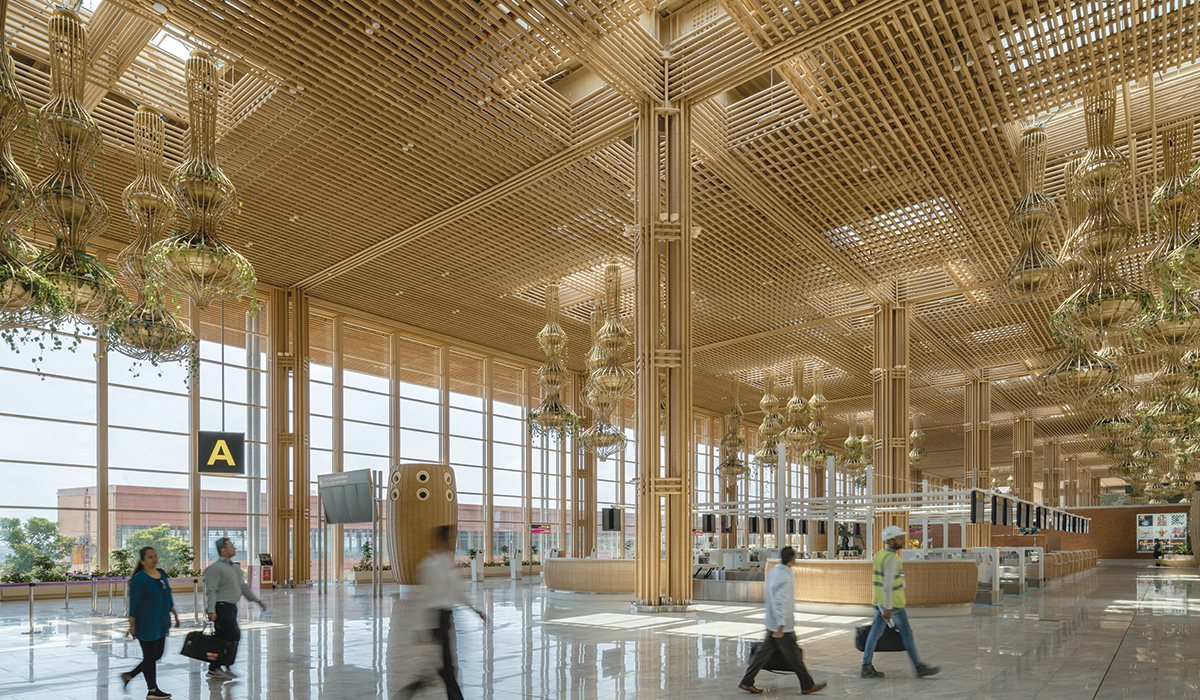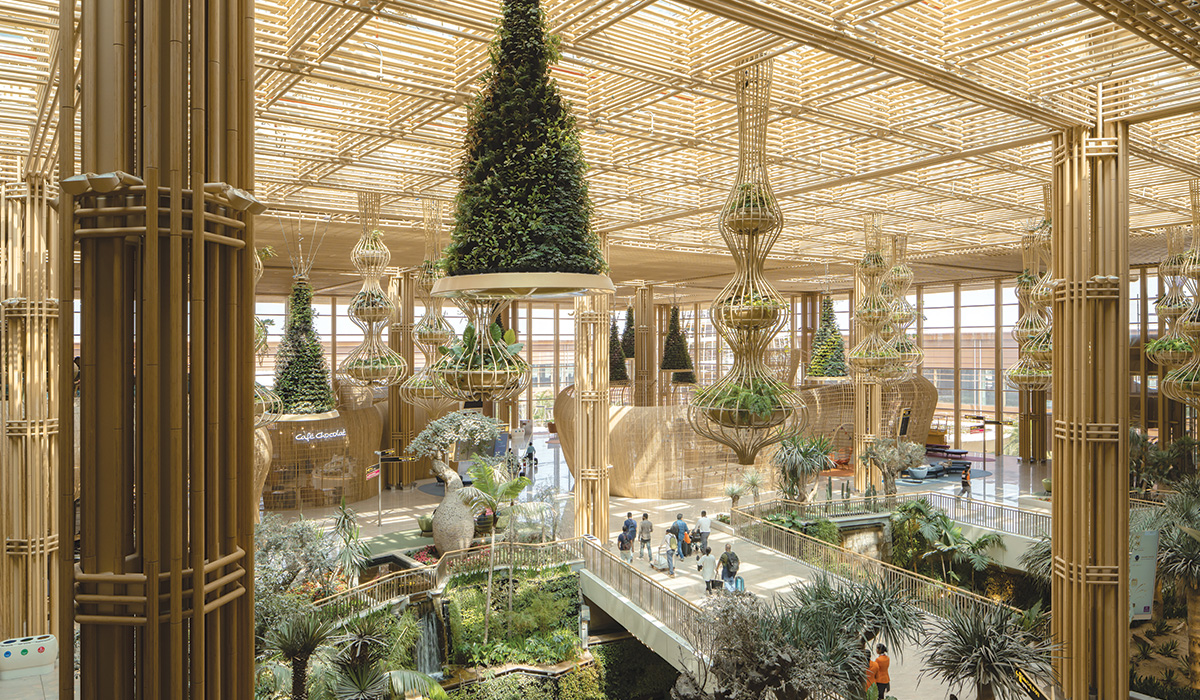The newly constructed Terminal 2 marks a transformative moment for one of India’s largest cities and establishes BLR Airport as one of the world’s premier airports. Clad in brick, engineered bamboo, and glass, the complex consists of a set of interconnected buildings tied together by a continuous band of outdoor, landscaped spaces designed in collaboration with Grant Associates and fashion designers Abu Jani/Sandeep Khosla.
 Photography: Ar. Ekansh Goel © Studio Recall
Photography: Ar. Ekansh Goel © Studio RecallIn this connection to nature, the design rethinks the homogenous architectural language of many of the world’s airports. The structure that houses the 11 gates is pulled away from the main complex that contains arrivals, check-in facilities, security checkpoints, baggage reclaim, and a retail pavilion, and the two are connected by an expansive, outdoor “forest belt.” This lush, landscape is replete with indigenous flora, multilevel meandering paths, and two-storey pavilions clad in bamboo and inspired by traditional Indian cane weavings. A network of bridges and outdoor walkways provide a calming oasis within the bustle of an international airport. A variety of hanging plantings and skylights filtered through delicate lattices of bamboo make these spaces rich and sensorial.
The structure is orthogonal in form—variating from the more common curving airport roof structure—with long eaves that shade the curbs and float serenely into the interiors. Each of the building’s columns consists of a cluster of four bamboo-clad steel members, which carry the texture of the lattices down to the floor and enhance the sense of light and space within the terminal. Custom furnishings clad in traditional woven rattan and locally sourced ivory brown granite lend the terminal a sense of warmth and comfort. And within the retail portion of the complex, indoor waterfalls inspired by the boulders and waterways of Karnataka become signature focal points while cooling the indoor temperature.
 Photography: Ar. Ekansh Goel © Studio Recall
Photography: Ar. Ekansh Goel © Studio RecallThe structural system of Terminal 2 was designed with two primary goals: to achieve sustainability through structural efficiency, and economy through modularity. The result is one of the lightest terminal roofs in the world at this scale, made entirely out of domestically produced materials and built with local construction technology. The roof above the check-in and retail halls features long-span steel moment frames, supported by steel columns spaced 18 meters apart. The columns consist of four individual posts clad in bamboo and linked together. Because air travel is a constantly evolving, the consistency of the grid of columns will also allow for flexibility to accommodate changes over time.
The structural system for the gate areas is composed of long-span trusses, which help keep the walkways and sightlines clear by pushing columns along the edges. The base building is composed of a uniform grid of reinforced concrete moment frames, with larger, column-free spaces at the baggage reclaim and arrival halls to greatly improve functionality where foot traffic is highest. Throughout the terminal, the structural design accommodates the integration of the skylights and hanging planters, as well as landscaping at multiple levels, both inside and outside.
 Photography: Ar. Ekansh Goel © Studio Recall
Photography: Ar. Ekansh Goel © Studio RecallFor the front of Terminal 2, on the landside, the 123,000-sqm multimodal transit hub serves as a nexus for the entire airport. This T-shaped, two-level space—with parking, taxi service, and a rideshare zone along the access roads, and a lower-level metro and bus station—are situated in the center of the airport. With Terminal 2 to the east, Terminal 1 to the northwest, and the airport hotel to the southeast, the transit hub serves as an artery through which the whole airport is accessed with elevated pedestrian bridges, making the airport entirely walkable.
The transit hub also introduces a new kind of space for an airport. The hub has an outdoor retail and entertainment area, a bustling village of shops and events where city residents and travelers can spend a day. It is covered by a translucent, high-performance canopy composed of lightweight steel, and a glass and steel skylight that rise over the entrance to the metro station.
 Photography: Ar. Ekansh Goel © Studio Recall
Photography: Ar. Ekansh Goel © Studio RecallTwo lagoons, each sitting on the southern side of the hub, will recycle the airport’s stormwater runoff and create a serene atmosphere. This entire space will serve as a new civic square for the city. The rectilinear form of the transit hub and Terminal 2 make for an exceptionally efficient use of the site— enabling flexible aircraft parking, uniformity among the gates, and modularity in the terminal’s construction.
All of the terminal’s gates will be equipped with “swing” capability, or the flexibility to handle single wide-body aircraft for international flights or two narrow-body aircraft for domestic flights. Because of this adaptable plan, the gates will rarely, if ever, sit idle for long periods, and future-proof the terminal as aircrafts continue to evolve.
 Photography: Ar. Ekansh Goel © Studio Recall
Photography: Ar. Ekansh Goel © Studio RecallT2 has been recognized as the largest terminal in the world to have been pre-certified as a LEED Platinum building by USGBC (US Green Building Council), prior to commencing operations. The terminal has also received the IGBC (Indian Green Building Council) Platinum certification for its sustainable architecture and design.
Beyond its visible features, the terminal employs numerous sophisticated sustainable innovations, including extensive solar shading and intelligent building systems, as well as renewable materials. The terminal, which will run entirely on renewable energy, will also capture, treat, and reuse rainwater from across the airport, and the indoor plantings and outdoor gardens are designed to only require the water that is harvested on site. The transit hub will help alleviate traffic and further limit pollution. The new transit hub is a striking gateway that will increase the airport’s annual passenger capacity by 25 million.















